
Fountain in a park, Victorian Village, Columbus, Ohio.
I once called Columbus “the new Midwestern star,” noting that they were one of those Midwest cities that’s doing far better than the region’s reputation would suggest. It’s been growing at a reasonably rapid clip in both population and jobs, beating the US average significantly, though not measuring up to the Sunbelt boomtowns. Home to Ohio State, it’s educated to significantly above the national average, has a diverse white collar employment base, and is also an emerging logistics center among other good things.
One of their biggest sources of frustration is that they aren’t better known in the marketplace. If I were to sum it up, they’re sick of people always putting the “, Ohio” after their name. (As I’ve written extensively about Columbus, Indiana in my own home state, hopefully they’ll forgive me if I do so in order to reduce ambiguity). Part of the reason is that while they check all the boxes, they haven’t really gone beyond the checklist to create things that would be truly compelling in the external marketplace. Columbus is basically what I mean by the “best practices” city – they are implementing all the best practices in the marketplace, but haven’t yet developed a compelling, unique brand positioning. I wrote about this in a post called “Rebranding Columbus” and focused on it at length in that presentation above. I’ll soon be back with another round of thoughts.
Short North
But today I just wanted to share some photos of various things going on about town. Like a lot of places, Columbus has seen a sizable amount of housing construction of apartments in its urban core in recent years. According to Walker Evans of Columbus Underground, there are about 5,000 units recently completed, under construction, or soon to break ground. That’s not going to reverse suburbanization, but shows that the urban center is showing significant signs of a more healthy market.
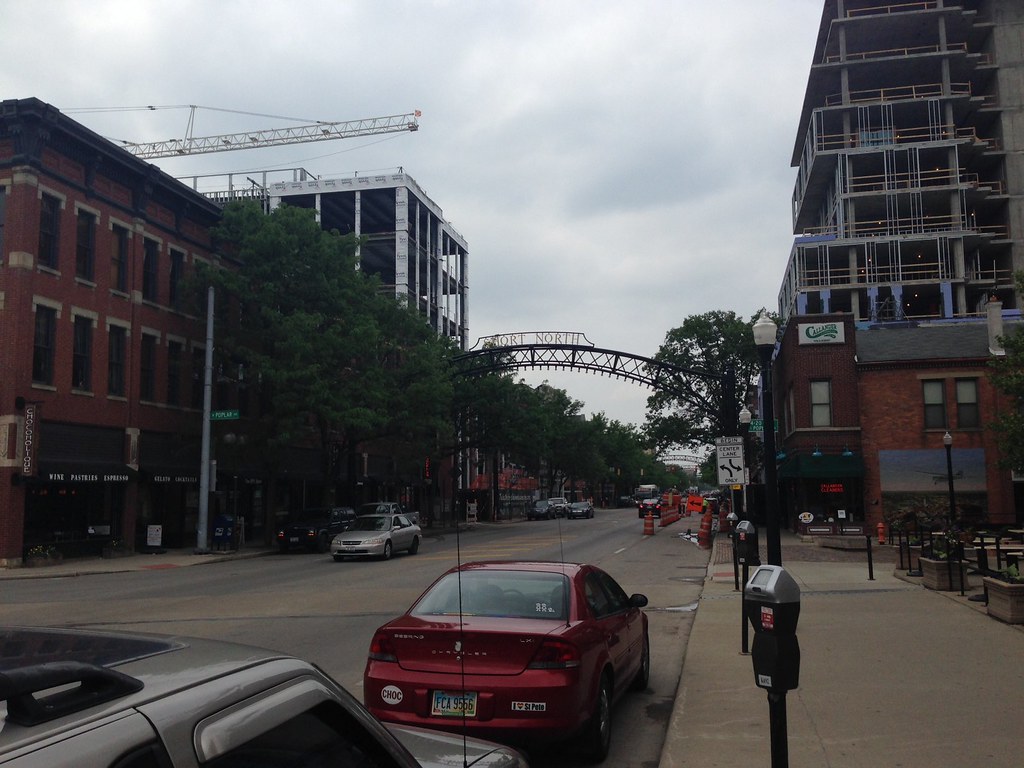
New construction on High St. in the Short North, Columbus.
You’ll see buildings under construction on both sides of the street, both showing increased verticality versus the existing building stock. This illustrates the densifying trend in arguably the city’s most desirable district, which has been provisionally welcomed though not without controversy. The building on the right is a Le Meridien hotel. The building on the left is for offices. It will also house a two-story Anthropologie store, which is very controversial for this neighborhood that has successfully fended off most major chains, including Starbucks.
Victorian Village and Italian Village
Short North is not exactly a neighborhood per se, but rather a commercial spine that joins (or splits depending on your point of view), residential neighborhoods on either side, Italian Village to the east and Victorian Village to the west.
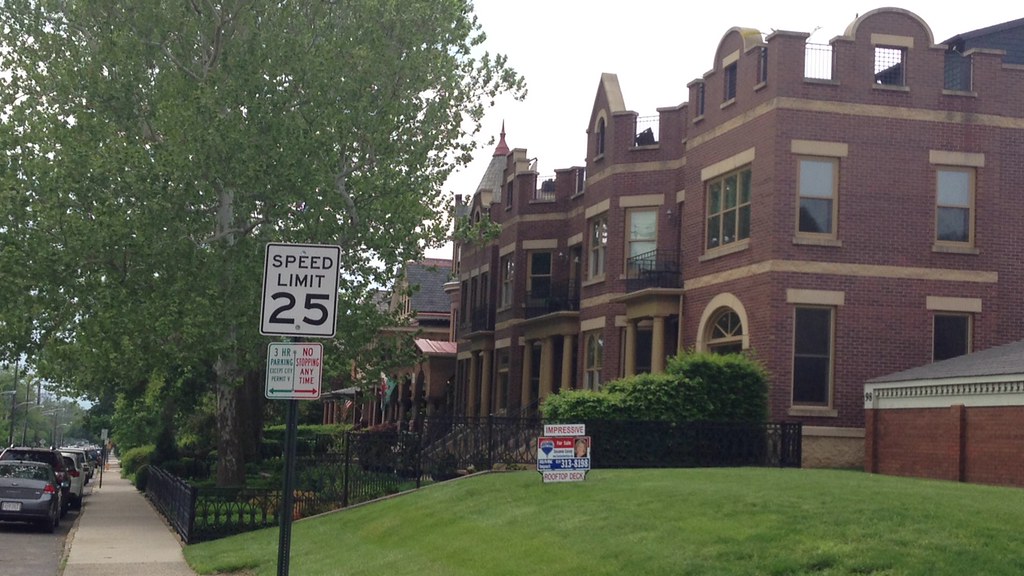
Street in Victorian Village
Walker Evans graciously gave me a tour of new development and I took a lot of snaps, but didn’t make notes so I’m going from memory as to where these are. Apologies in advance if I make a mistake as to location in these photos. Here’s new development in Italian Village:

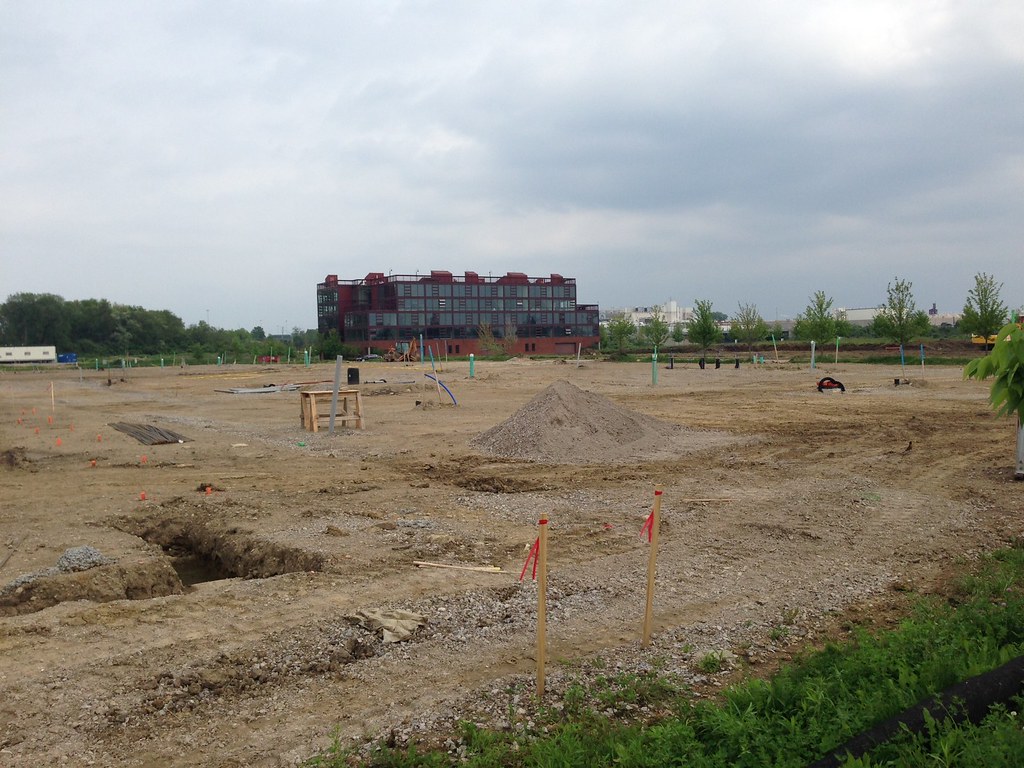

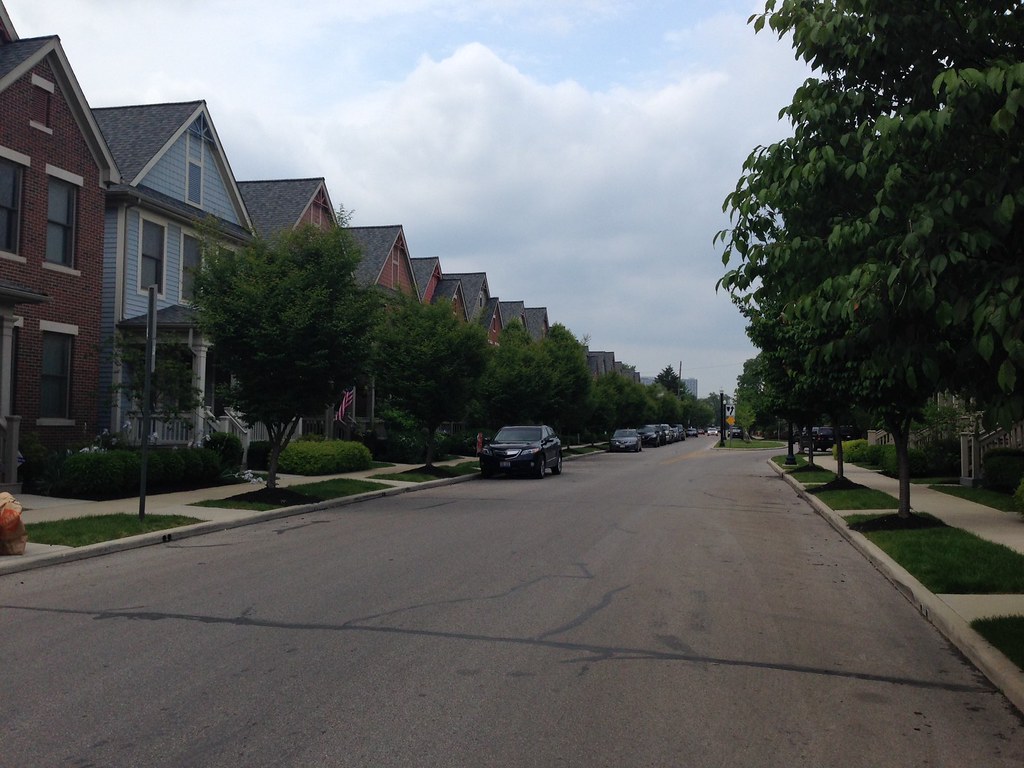
Grandview Heights Area
Columbus is famous for having annexed a large amount of territory. One result is that there area handful of independent municipalities that ended up entirely surrounded by the city, including Bexley and Grandview Heights. Because these have their own independent school districts, they’ve retained a lot of housing value and have a pretty high quality residential stock. The closure of some industrial plants led Grandview to try to replace the lost tax base by redeveloping them as mixed use residential/office/retail. Here’s a picture under development:


Easton Town Center
I’ll make a brief diversion to a suburban type location (albeit within Columbus’ sprawling city limits). This is the lifestyle center Easton Town Center on the Northeast Side. It’s Columbus’ most upscale mall and also some to some associated apartments and a bit under three million square feet of office space. This gives the appearance of having been a completely master planned development. While it’s nice, it’s also sterile – “Stepford” as my one friend might call it – and also exudes the “Sim City” effect.

An interior street of the Easton Mall.
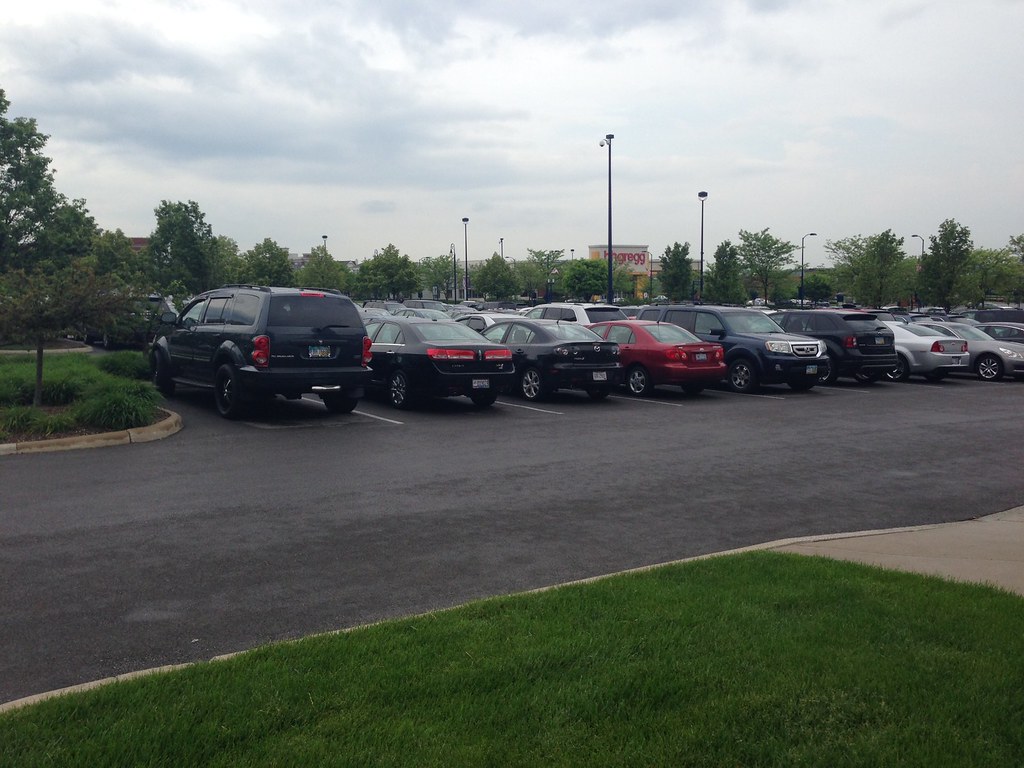
Parking lots only steps from the interior street above.
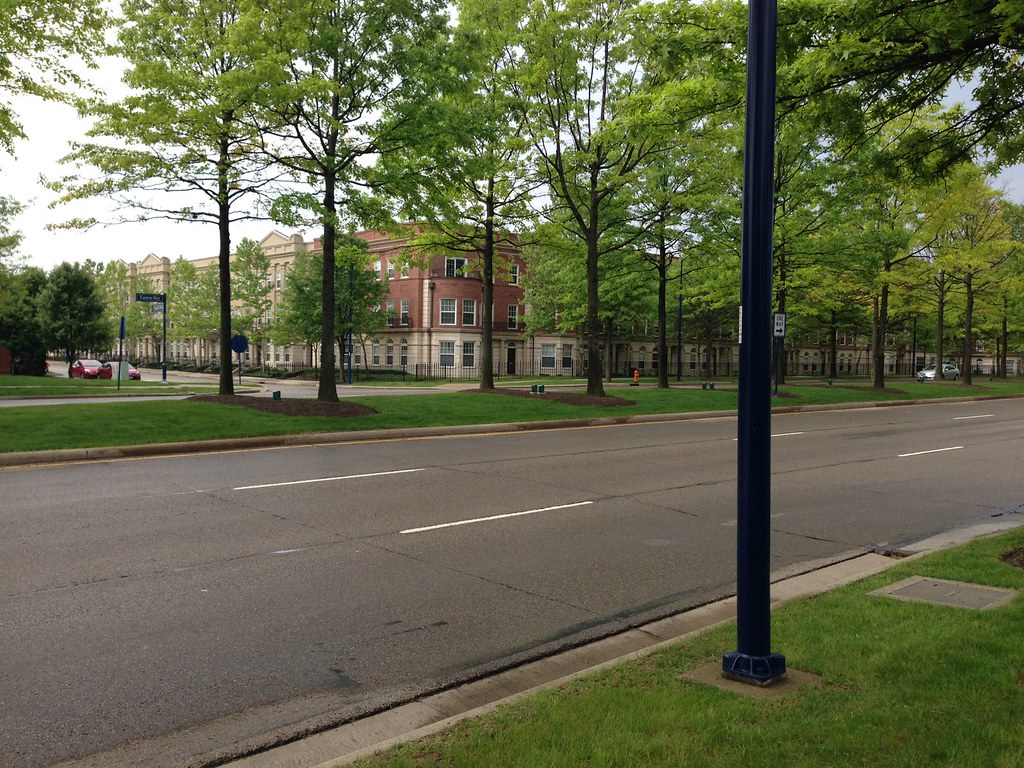
The extensively landscaped main access road at Easton, with new urbanist style apartments in the background.
Downtown
Columbus has a number of great and thriving urban core neighborhoods like Short North and German Village. Its downtown, by contrast, has been on the dull side, a stereotypical government and finance center. I didn’t see that a huge amount had changed since my last visit. Indeed, most of the development in the core seems to be outside downtown.
One exception is the site of the now-demolished City Center Mall. When the city scrapped it, I was not a fan of the idea of replacing it with a park, saying:
There seems to be a reverence for green space in cities bordering on the religious. But green space is only useful to the extent that it functions well in the urban fabric. If you take two blocks and grass them over like this, what you are really doing is just institutionalizing a vacant lot. Now a plaza or square of the European style is quite nice, but it is quite nice because those places are able to draw people. If 1.3 million sq. ft. of shops wouldn’t draw people, why will this park? That’s the great unanswered question. Plazas work in Europe because of the density of offices, retail, residential, and tourists. The activity on the plazas draws more people to be part of it, which forms a virtuous circle, but unless there is critical mass of activity to begin with, the spark will never strike. The intensity of development here is just not going to make it. In effect, this is another build it and they will come plan. What’s more, the city is permanently taking the land off the tax rolls and since, unlike a mall, it’s a non-revenue producing asset, there is a significant operating tail to fund as well.
City officials are correct that cities have to get their public spaces right. But the key part of a public space is the public. If you don’t have people, you haven’t built a true public space. I suspect that they will be forced to program events there near continuously to fill up this space.
My prediction appears to have been entirely vindicated. Here’s the park they built:
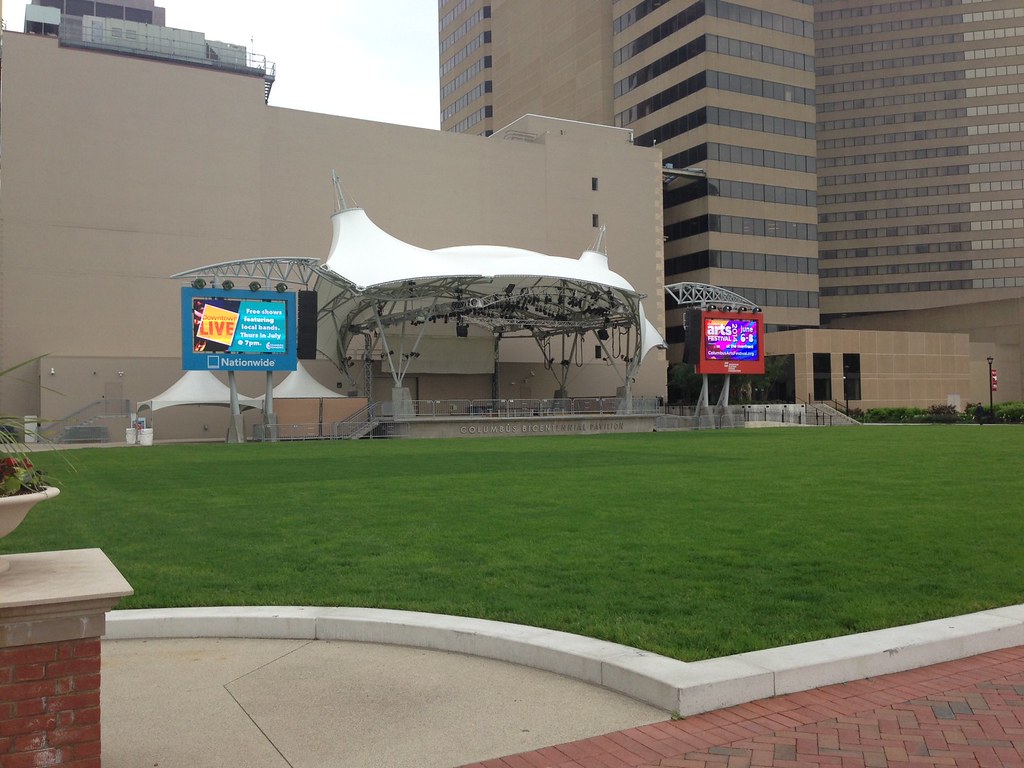
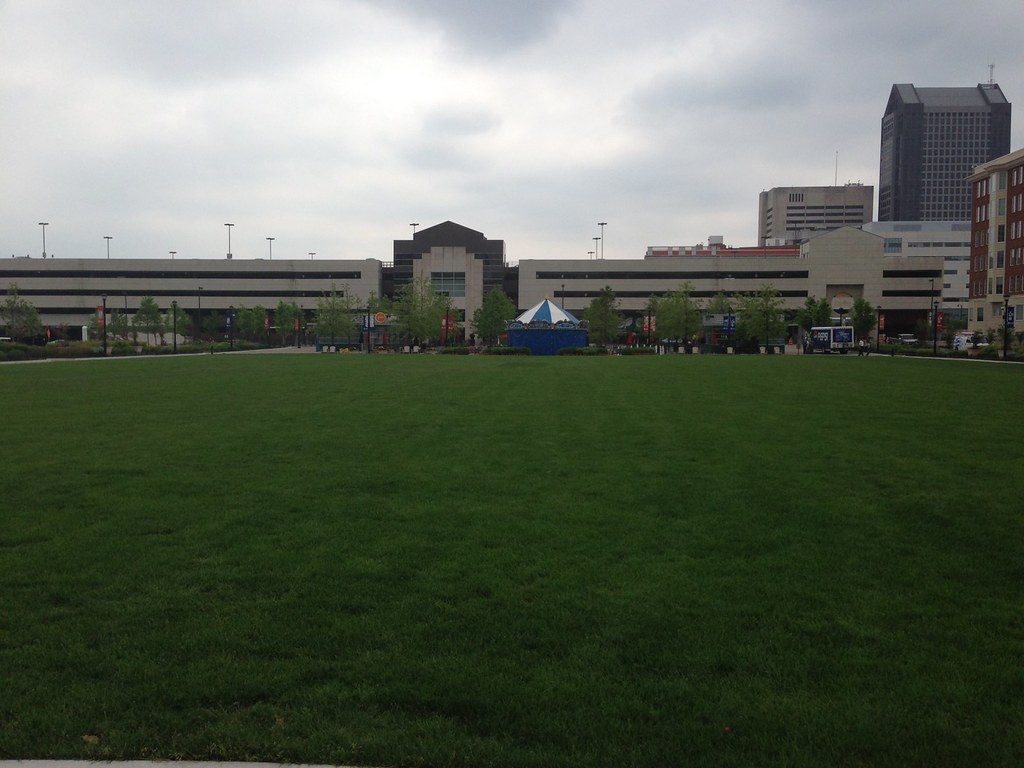
On the other hand, this is one area that has seen development. Only part of the site was reserved as a park. Various other sections were penciled in for development, which has been occurring. Here are some apartments that have attracted quite a bit of urban design criticism locally, but I find notable as being erected by an out of town developer, showing the increasing attractiveness of the local market for national investors:

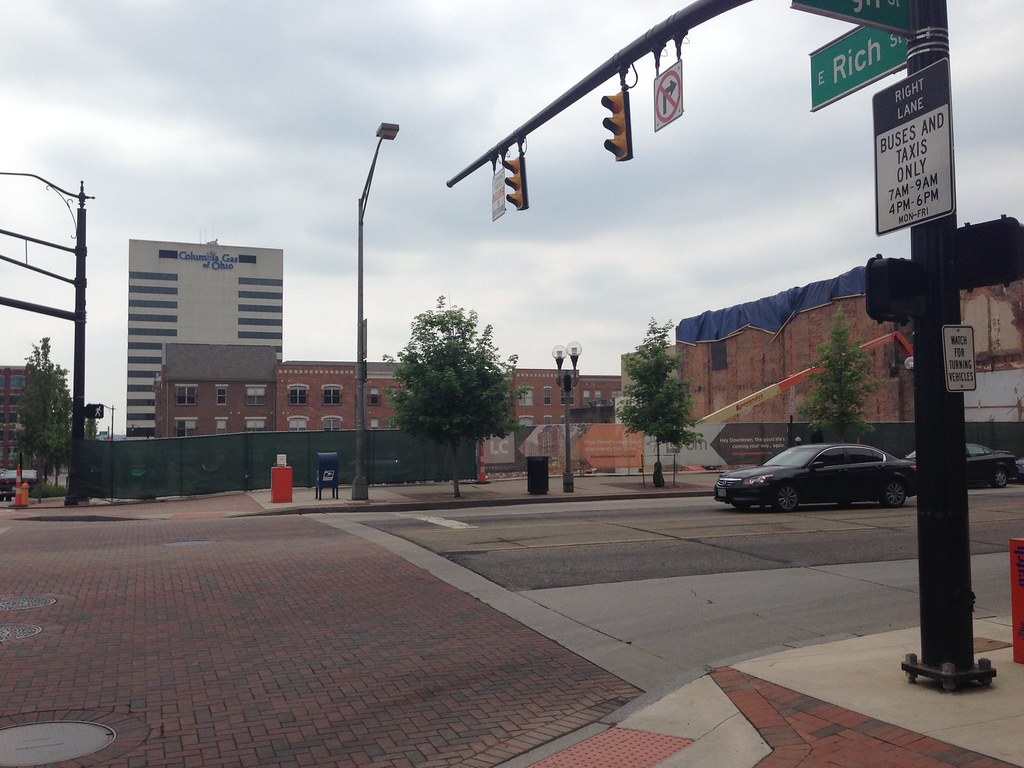
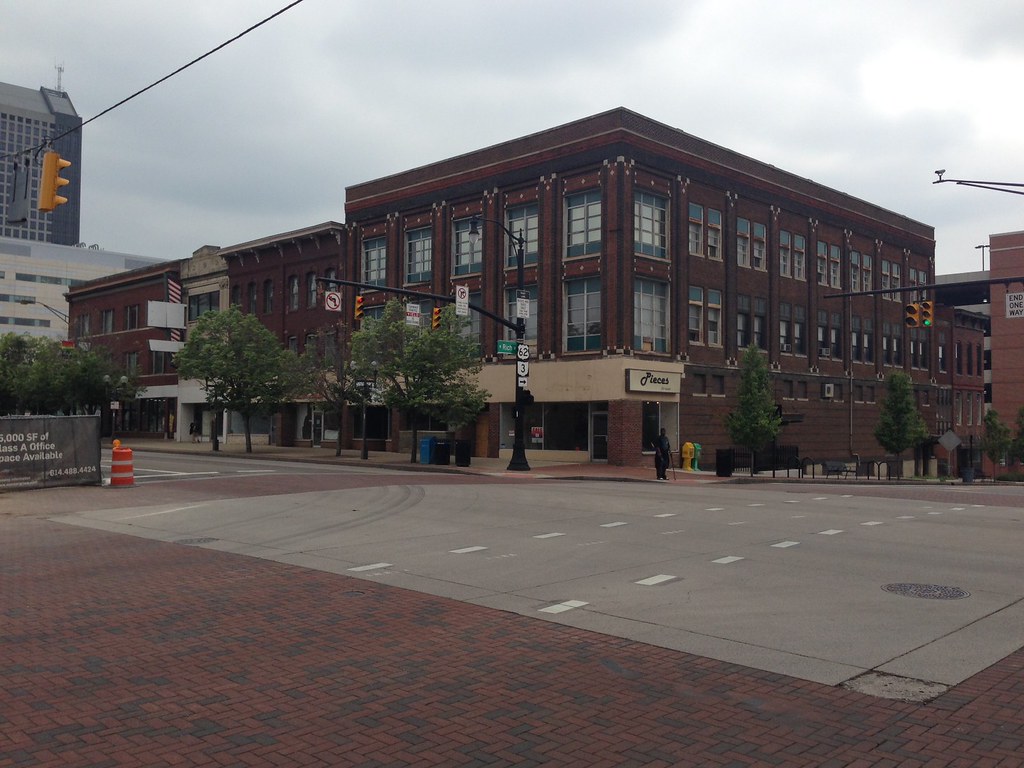
Riverbank Restoration
One other interesting thing going on downtown involves changes to the Scioto River. Previously the city had redone the existing banks of the river with parkland and trails called the Scioto Mile that is quite nice. We had drinks at a tavern that overlooked the river in a way that was both urban and scenic.
However, sometime in the past the river had been dammed. Nobody is quite sure way, but the best guess is that it was to widen the smallish, non-navigable Scioto to make it more impressive. The result is that the river ran through a channel within retaining wall through downtown. Trails and such were built along the top of that wall.
The city recently blew up the dam in order to restore a more natural riverbank and greenery to the Scioto. Although in this case “natural” clearly involves a lot of restoration work to help.
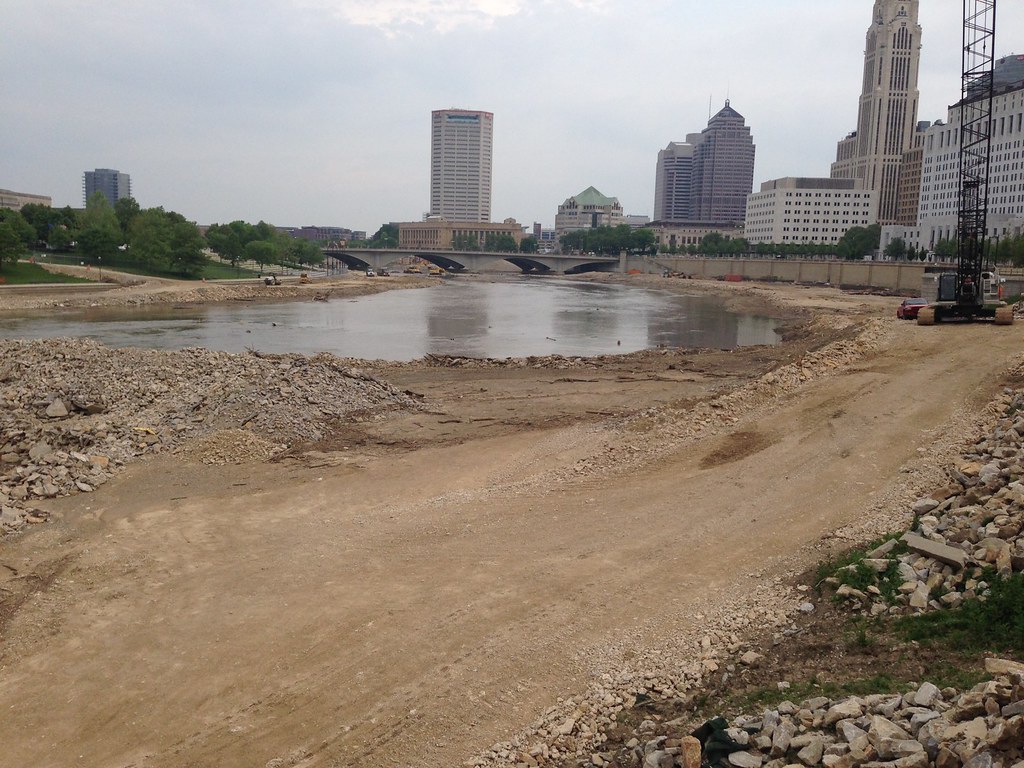
Franklinton
Visiting Columbus you might be tempted to ask, “Where’s the urban blighted part?” Candidly, I’ve seen remarkably little of it compared to many cities I’ve visited, and I tend to go looking for it.
One exception is a neighborhood just west of the Scioto River called Franklinton that is the thing that has almost everybody I talked to most excited.
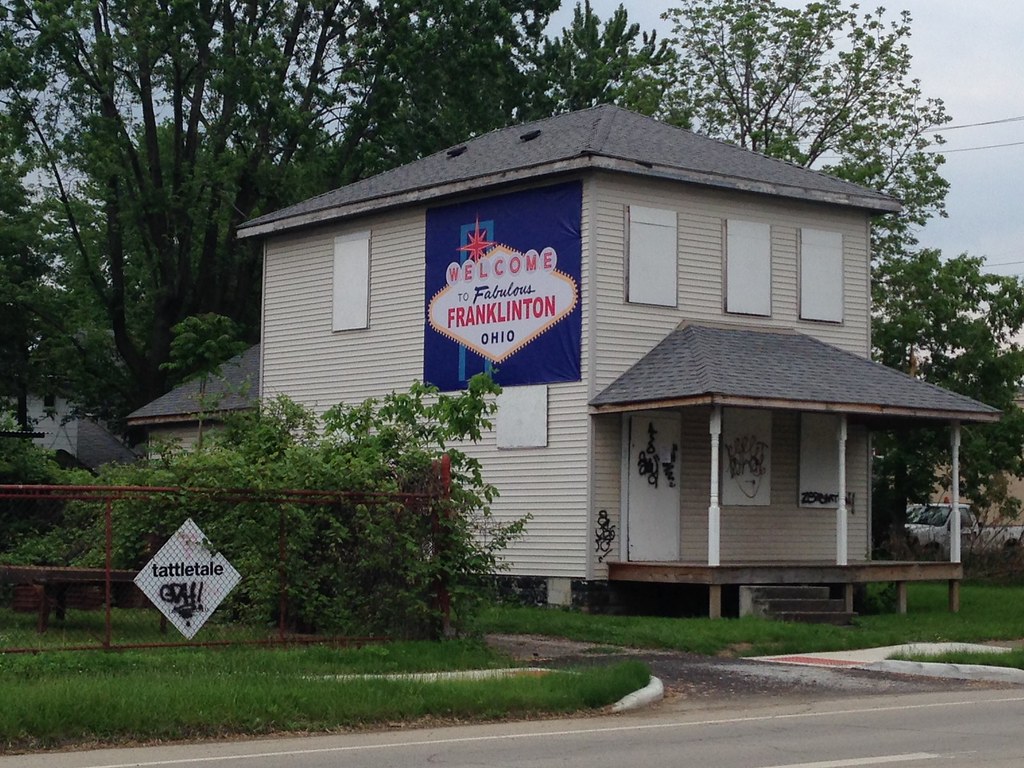
Bike and Care Share
Columbus now has a downtown bike share up and running, though I didn’t actually see anyone using it. It appears to be industry standard type stuff. They also have a car share system, this one from an outfit called “car2go” that I wasn’t familiar with. It’s apparently owned by Daimler Benz, so naturally features Smart Cars:
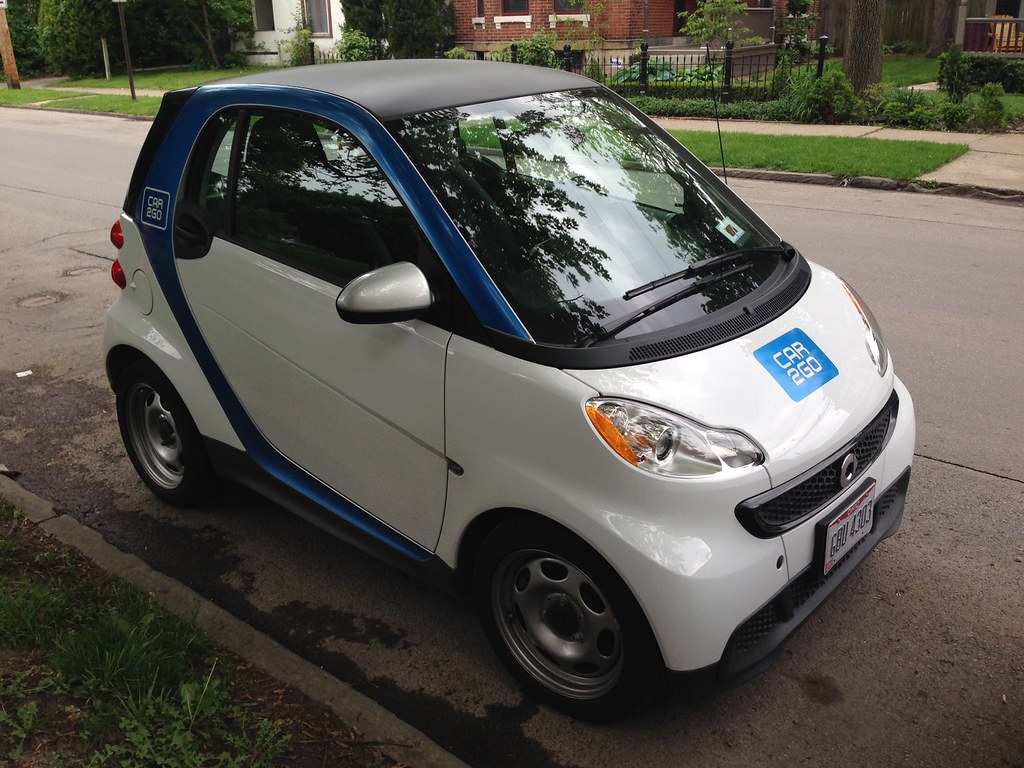
Bicentennial Brand
One new thing since my last visit was a new city logo:
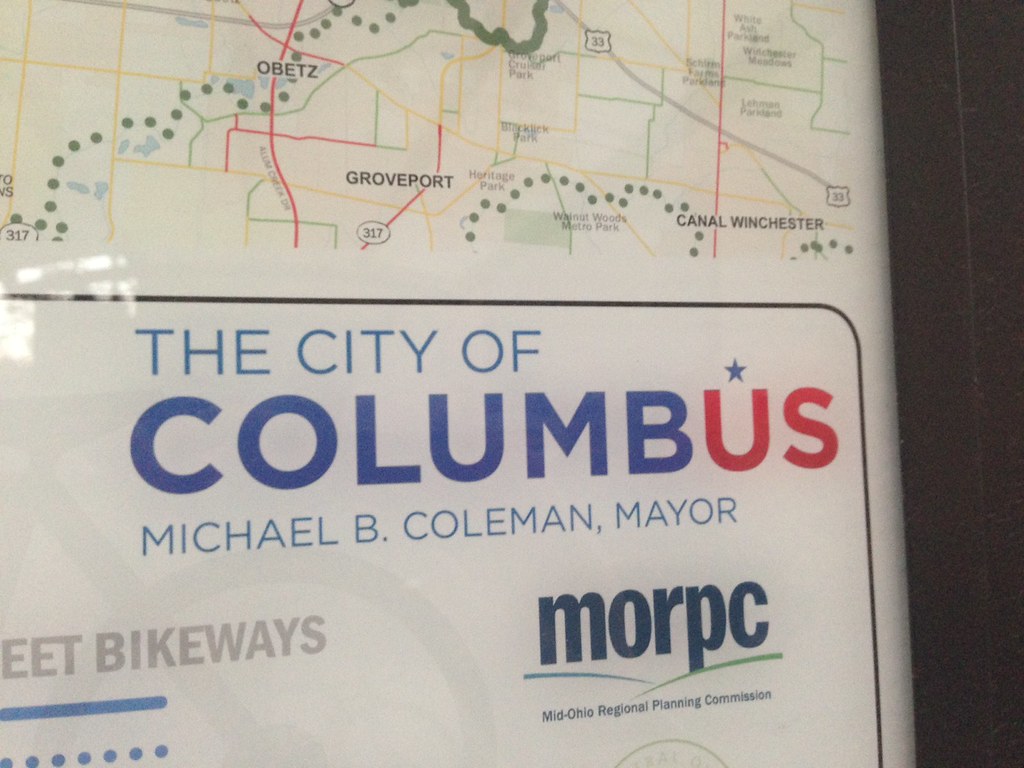
Or so I was congratulating myself for having figured out. Apparently this logo was created for the city’s bicentennial, which had a theme of self-celebration called “The Story of Us.” There was even a book with that name issued (along with a commemorative coin, CD, and other celebratory things). The highlighted “US” is actually the pronoun “us.”
While I think this works great as a bicentennial theme (and also explains the red white and blue, even though those aren’t the city flag colors), it renders the logo unparseable to anyone on not on the inside, i.e., everyone not from Columbus. Especially foreigners are unlikely to make the connection. Unfortunately, basically every major civic group has adopted variations of this for their own materials. The graphic uniformity is admirable, but it’s a confusing graphic.
Conclusion
I hope this gives a bit of a feel for what’s going on in Columbus, though it’s by no means complete. The city continues to grow at fairly robust levels. Construction in the urban core looks healthy. But there hasn’t been any upward inflection point in the trajectory that I see. Nor have they cracked the code on brand, marketplace recognition, and transcending the best practices city model. I’ll share some thoughts in coming posts that will hopefully help with the latter items.
Great post about what’s happening in Columbus! It was great to catch up with you while here!
It was a shame that Columbus Commons was so dead while we were there, but that is true that it’s representative of what the park looks like on a Tuesday early afternoon with an overcast sky. 😉 The Commons operators (CDDC – Columbus Downtown Development Corporation) do a great job with programming, which really kicks off Memorial Day Weekend. Bands and food trucks filled the park this past Friday night with “Family Fun Day” on Saturday and Shadowbox Live’s big Woodstock-centric theatrical production “Back to the Garden” on Sunday. Yoga classes, kickball leagues, food truck nights, the Columbus Symphony, Shakespeare in the Park, outdoor movie nights and plenty of other events will keep it busy all summer long:
http://www.columbuscommons.org/happenings/event-calendar/
I agree with your assessment that Columbus is a city doing a lot of things well, and has an impressive list of accomplishments when you start running through facts and figures and checkboxes. An exploding microbrewery scene? Check. Car/Bike share systems? Check. A vibrant local art scene? Check. A unique collection of urban neighborhoods? Check. A young, hip, smart and gay-friendly demographic base? Check. A stable job market and affordable quality of life? Check.
But checklists are boring. Facts and figures are boring. How do we elevate what makes our city unique and how do we capture that for our city’s identity?
I kind of wonder if we even need to. My experience is that with visitors to Columbus having no expectations of what they’ll find (not low expectations… but no expectations at all) generally leaves them pleasantly surprised by what they’ll find. Of course, the argument could be made that Columbus would be growing faster if more people realized the assets and amenities that the city currently has in place, but I’m not sure if a boom-and-bust cycle is something that we need to aspire to like the sunbelt cities that have led the population increase race in recent years.
Anyway, looking forward to your interview with Mayor Coleman! 😉
“out of mercy to the city”……. says it al.
Great pictures but when did you take them so there were no people in any of the shots?
@Joe, it was a weekday afternoon. Some of the areas were legitimately empty, like the downtown mall replacement. Some of them were residential streets, of which even your average one in Chicago often has no pedestrians during the day.
But I often try to avoid shooting people in pictures after a bad experience on the East Side of Indy when I was threatened by someone who was in the direction I was pointing my camera.
I haven’t been back since the downtown dam was removed so it’s been within the last few months. If memory from history class serves me correctly, the Scioto was originally widened not only because of the city beautiful movement (a wider river looking more impressive–even though I think it was only a few feet deep), but also as flood control following the flood of 1913 (the year might be off a little). It was also a way to get rid of the small industry located along the banks that was polluting the river.
Columbus is pretty interesting… and I think it shows how a city with little name recognition or cultural identifiers on the national stage can attract a significant amount of growth, even growth of a fairly urban variety.
Columbus hasn’t really made the investments in transit service to build pedestrian areas and make all this density truly urban, but it seems like they’re already putting the bones in for a later transition by allowing for residential density and decent urbanist form.
Thanks, Aaron. I enjoy your “in the field reporting.”
Columbus looks okay.
I’ll throw this out there for what it’s worth. From a distance, what makes Columbus unique beyond its status as a combo capital / major university town is its geographic location at the northern edge of a great under-appreciated geographic region — America’s MidSouth.
The MidSouth includes roughly Columbus, Indy, St. Louis, KC, Tulsa / OKC, Little Rock, Memphis, Louisville, Cincinnati, Nashville, Chattanooga and Knoxville. It’s not the Deep South but it’s decidedly Dixie. It has milder winters than the Great Lakes region and milder summers than the Deep South. Basically, this is where the SEC meets the Big 10 and the Big 12.
The MidSouth is the home of Walmart, Monsanto, Kroger, P&G, Eli Lily and other Fortune 500 companies. Also, Ohio State, Indiana University at Bloomington, University of Missouri, St. Louis University, Washington University, Kansas University, Oklahoma University, Oklahoma State University, University of Arkansas, Memphis State, University of Tennessee, University of Louisville and Kentucky University among others.
The tendency in Midwestern states is to look towards Chicago. But many places like Indianapolis, Cincinnati, St. Louis and Kansas City have their own unique legacies and geographic advantages. Perhaps Columbus should re-evaluate theirs and look southward as well as northward.
@Carl Wohlt,
Columbus is “decidedly Dixie” from what vantage point? No history of slavery, totally different immigration/migration patterns (well okay except for its Sunbelt features, but those certainly aren’t shared by e.g. Cincinnati or St. Louis). It just seems like a way of painting with a broad brush from the perspective of someone from the northern Great Lakes region. How is it any more accurate than someone from Mississippi saying Nashville is “decidedly Yankee”?
As someone with Alabama family roots, I don’t equate Columbus to the south at all. Cincinnati certainly has more in common, and much of rural southern Ohio starts to have a bit of an appalachian twang, but Columbus is distanced from that to not have much of a cultural, economic or social impact.
If anything, it sits more at a crossroads. It’s too far north to be “MidSouth”. It’s about as far east as you can go in the Midwest. It’s pretty far west for being in the Eastern timezone, though still not too far from the East Coast (6-7 hour drive to DC, Baltimore, Philly). And even though Windsor Canada is a little over 3 hours away, it’s not exactly a far north city, either.
Columbus was never an industrial base, so it doesn’t have a whole lot of “rust” for sitting in the center of the rust belt. There’s really not a lot a ton that Columbus has in common with many other cities in the region, which is certainly unique, but not exactly a strong identifier.
In the meantime, I’m perfectly ok with Columbus not being easily definable. I think we’ll eventually figure out how to package that and run with it.
Jord — I get your point, but read again. Columbus is on the edge the region I described. If you haven’t been south of Columbus, I understand your confusion. “Dixie” culture is more than slaves — it’s also food, art, music and literature.
Aaron — I don’t think I’m changing the topic of discussion, but cut me off if you think I am.
Cities like Columbus, Indianapolis, Springfield (Illinois), St. Louis and Kansas City have a unique geographic opportunity that I have not seen leveraged to date. They get lumped into categories like “Great Lakes region” or “Midwest,” each of which has advantages, but since the demise of U.S. manufacturing, many more disadvantages.
The MidSouth geography I suggest seems to have enormous opportunities in terms of long term quality of life for talent and investment.
It’s approximately a half-day to day drive to Chicago and the same to the Gulf Shore. It has milder summer / winter conditions.
Overall, great opportunities for those who are thinking globally. Columbus — with its intellectual and political capital — is right there in a position to be a major leader rather than play second fiddle to Cleveland, Cincinnati or even Chicago in an emerging MidSouth Region.
Of course, this goes against everything that’s been vetted so far regarding strategies that might re-invigorate and redefine the Midwest. I can’t imagine the Big Brains that might explode at these thoughts, but there they are…
For what it’s worth, in Richard Longworth’s book Caught in the Middle on the Midwest and globalization, his boundary of the Midwest more or less follows I-70, though in the case of Ohio it does dip a bit south of it.
Maybe not Southern, but doesn’t Columbus have a large Appalachian population?
Columbus doesn’t come across as Southern at all to me, but clearly its heritage is different from cities north of it. Midwest cities were dominated by heavy manufacturing, especially autos and metal, and unions. Columbus has manufacturing, but nothing like a River Rouge plant in Detroit (100,000 employees), US Steel South Works in Chicago (60,000 employees) or the kinds of things than went on in Cleveland.
I-70 is an interesting road and there are a number of cities doing well along it like Columbus, Indy, KC, Denver.
Columbus does have strong Appalachian ties, but it’s more from West Virginia and southeast Ohio. This is unlike Cincinnati,where many Tennesseans moved north during the 30’s when the TVA relocated many folks.
Columbus is about 5-6 hours from Chicago and 12 hours from Mobile, as a reference.
The Sim City observation is a good one and could be fleshed out further in regards to many aspects of Columbus, economics, demographics, politics and development. As a former resident who grew up in Columbus and returns regularly- the utter and almost complete lack of anything distinctive, exceptional and specific that makes the built environment of Columbus noteworthy from other cities is disappointing. One aspect of Columbus is that the city seems to want to do ALL, regardless of how it might impact what was done before.
1. Tear down historic near North side of the downtown core- including an exceptional train station and spend huge sums of tax dollars to build a too small convention center and hotel with the most anti-urban design possible, fine.
2. Immediately, south of the traditional center of town, tear down 3 blocks of the historic fabric of the city- at least- saving the glorious movie house, spend huge sums of tax dollars to get built one of the the most inward looking vapid urban shopping malls in the nation. Of course the Sim City idea continues with naming the mall- “City Centre”.
3. The near south end of town gets developed as the Brewery District – historic buildings retained and new buildings are integrated and inserted into the area- all seems good , though a bit isolated – due to freeway and development is stifled due to German Village local opposition.
4. So we then the city supports a development on far north side a major retail and commercial development, Polaris- is built with huge public subsidies- this development in conjunction with Easton- again Sim City meets the Stepford Wives design, – kills “City Centre” retailing and the city spends millions to tear down the vapid mall and build a vapid “park”. Your notes on green space and in particular Columbus Commons is dead on- the programming link posted later – indicates just how bland, standard and typical the “entertainment” for that venue is. The list could go on…the Short North area develops over time- bit by bit- a freeway cap is built to strengthen the High Street spine and the Arena District takes off- due to a deep pocket and massive public subsidies, the Sim City, new urbanist thinking and “tasteful” design pervades- any distinctive or noteworthy architecture is not to be seen. The Brewery district on the south end is eclipsed. Dublin now will try its hand with a Sim City development- public cost yet to be determined…..I simply have seen little or no coordination between developments that build upon each other- creating a certain “urban vibe” or syn-energy that drives further development. And there is no reason – that with so much public dollars involved in these developments why the City of Columbus is not in-fact a more “urbane” city.
@George – As far as I’m aware, there’s an appalachian-migration population in limited parts of the south/southeast side/suburbs of Columbus. Not exactly what I’d call “strong Appalachian ties”. Columbus has a similar Somali and East African immigrant population on the northeast side of the city, but I don’t think it’s a large enough demographic to proclaim “strong Somali ties”.
@Carl – Columbus is a 5 hour drive to Chicago. It’s a 13 hour drive to Gulf Shores, Alabama. Not exactly a similar comparison.
@mark – Most of your examples are things that happened 20-50 years ago. Aaron’s post is about what has changed in the past 5-10 years and what is transforming today. I would recommend that you revisit the city for a more current take on what is happening, but it sounds like you’ve already made up your mind that nothing good is happening in Columbus. And that’s fine, because you know the city is doing something right if it attracts a handful of haters here and there. 😉
It’s pretty apparent that I live in Columbus, and I love Columbus, but I can certainly be realistic about its shortcomings and areas where improvements can be made. At the same time, the “perfect is the enemy of good” mindset that way too many armchair urban planners fall into fail to understand that not every aspect of life needs to be earthshatteringly innovative to provide a pleasant day-to-day experience. Don’t let your impossibly high standards prevent you from understanding that other people are capable of enjoying their lives in their not-as-urban-as-i-think-it-should-be inferior worlds.
Aaron correctly noted that Columbus is dominated by the state government and tOSU, and it doesn’t have the industrial legacy that most other Midwestern cities have. The combination of state capital and major university is very powerful, and gives Columbus a different set of peers:
– Madison, WI
– Austin, TX
– Lexington, KY
– Raleigh, NC
– Minneapolis-St Paul, MN
– Baton Rouge, LA
In most of these cases we see the same stereotype – a youngish city with comparatively few slums and brownfields and a well-educated and mostly white-asian population (and relatively few blacks and hispanics). In most/all of these cases, these cities have been out-performing the rest of their state in terms of population growth and incomes, whether the state is doing well (TX, NC) or not-as-well (OH, WI).
In general, these cities have all of the advantages/disadvantages of their state, plus a few “special advantages”:
* A lot of medium-to-well paid government and university workers who never get laid off
* A extra dollop of well-paid lawyers and lobbyists supporting some high-end restaurants, associated with the capitol
* A lot of promising students – the creme of the state’s high schools – who not only spend a lot of money and generate an automatic “cool neighborhood” full of bars and clubs. A sub-set of them will never leave, adding to the “well educated” reputation of the city.
Combine that with being low-crime (few slums or run-down industrial housing districts), the cities understandably become quite popular.
The problem is that this is not a replicable model – no state can have more than one of them. Also, while no one in these cities ever says so, their relative prosperity is partly parasitic: they get the taxes from the rest of the state to support the capitol and university. Especially in struggling states (like OH and WI), the task of the older, industrial cities (like Cleveland and Milwaukee) is made harder: not only do they have to adapt to wrenching economic change, they must do so while subsidizing Madison and Columbus with their taxes and the brightest of their children.
@ Walker-I would tend to differ. Columbus has the second largest Somali population in the U.S. Sure, it’s not 20% of the population on anything, but it’s been enough to make an impact on the cultural and urban fabric of the City.
I think the Appalachian connection is the same. Particularly on the south side of town. If you notice, most of the north side is more tony upper income suburban and neighborhoods (with a few exceptions like Linden). The south side however, is fairly bereft of urban amenities, and has a much higher Appalachian population. It’s kind of the “forgotten side” of Columbus, but it’s part of our city, and the people are as well.
@ Aaron-
I beg to differ on your analysis of the Columbus Commons. We had a dead mall. For better or worse, that’s what it was. Our choices were 1) leave it there to rot or 2) redevelop it.
So we chose to redevelop. Now, what do you do with this big chunk of land? First, we’ll talk philosophical. It’s a Chicken and Egg problem. You want the chickens first-i.e. dense development to activate the site. We went with the egg first, for several reasons, listed below. However, much of the development in this part of downtown, which is booming suddenly, can be attributed to the combined effects of this park and the Scioto Mile. Developers have said as much, including Carter, the ones that built the Highpoint Apartments in your photo. This area was a wasteland before the parks. I think you need to wait 20 years before judging.
Second, the parking garage under the mall made it very difficult to redevelop a large section of the land. Unless you essentially redeveloped another building with the same footprint over the garage, you would have to retrofit with costly support columns to support most development, drilling through the existing garage while trying to keep it open. The corners are reserved for development partly because they DON’T have parking garage under them and can support the weight of large buildings. It made much more sense from a physical standpoint to reserve the central area as greenspace and leave the underground parking functional, vs. trying to rip holes in it to support dense development that in an area with no amenities available. The Commons added an amenity while solving the structural problem at the same time.
As someone with Alabama family roots, I don’t equate Columbus to the south at all. Cincinnati certainly has more in common, and much of rural southern Ohio starts to have a bit of an appalachian twang, but Columbus is distanced from that to not have much of a cultural, economic or social impact.
The southeastern third of Ohio, roughly a line from Brown County to Youngstown is legally defined as Appalachian. This includes several exurban counties of the Columbus metro.
The point: Columbus doesn’t have to import Appalachian people from out of state, there are plenty in state. [Though I was born in Bexley, both sides of my family hail from Appalachian counties, except for the grandmother who grew up in German Village back when it really was a German village.]
This gets to my point, addressing Carl Wohlt: there are two kinds of Appalachia, northern and southern. Though the culture and food are similar (think “soul food, minus greens”), northern Appalachia (roughly north of I-64/79/68), is definitely not “southern” or “mid-south”.
Northern Appalachia is all about coal and steel and aluminum…basic industry…stretching from Bethlehem PA to Ravenswoood, WV. Northern Appalachia’s capital is Pittsburgh, undisputed. Columbus can’t muscle in on that. It’s flat and inland, as pointed out above, very near the southeastern edge of the Midwestern geography. Columbus got (and still gets) Appalachian refugees leaving rural and small town life.
Aaron, you have rightly pointed out the downfall of “best practices” benchmarking as opposed to doing what you call “finding the white space”: SimCity feel.
But that is one of the biggest differences between Indy and Cbus, and both are now feeling the effects of their chosen strategies: the string ends in disappointment. Indy lost the Super Bowl bid and the B1G basketball tournament. Columbus has an inauthentic, undistinguished feel.
So, does each city go back and work on its weaknesses? Indy builds “100 Monument Circles” and Columbus works outside the checklist/best practices model on something unique?
Chris-
I wouldn’t say Columbus has a totally inauthentic, undistinguished feel. What it does have are a lot of space to develop. On these large tracts, it’s difficult to get a feel of an old neighborhood. Bigger buildings in master-planned tracts are by nature going to feel more, well, master planned.
However, there are also many great old, authentic nodes, from German Village and the Short North, which are quite urban, to Clintonville and Grandview Heights and Bexley-more streetcar suburban (technically Grandview and Bexley are separate municipalities).
Plus, a few people have succeeded at taking large tracts of land and developing more authentic-looking developments. Take a look at this downtown development:
http://www.neighborhoodlaunch.com/
Watch the slide show on the front. Most of these buildings look 100 years old, and have varying architectural style, but none of them are older than 10 years. The developer hired several architects to design each phase, which gives it a more natural look. Pretty smart.
I guess I’m not articulating my thoughts very well. Columbus is not a southern city, and it is historically more closely linked to the industrial Great Lakes. I’m just saying that it also lies at the northern edge of another region (MidSouth) that has the potential to create its own unique identity with potential global appeal. The region has traditionally been thought of as parts of the north or south divided by the Mason Dixon line, but I think geographically and culturally there are many similarities that make it distinctive in its own right. A lot of the cities on the periphery and within the region have been doing good things over the past couple of decades that I don’t think get enough attention and credit. Perhaps that’s because major urban centers outside the MidSouth such as Chicago, Atlanta, Dallas-Ft. Worth have been the shiny objects that people pay attention to. Maybe it’s a dumb idea, but in a future era of inter-state and regional cooperation, I could see states and cities coming together to collectively market the MidSouth as an area with its own distinctive assets and opportunities.
Carl:
I definitely think that Columbus’ location at a crossroads where Appalachia, the Midwest and the upper South meet is part of the explanation for its growth. In fact, if you could delete the other large Ohio metros and Chicago, Columbus might be a boomtown a la Denver-it’s becoming the capital of the Front Range. A good part of that is because 1) its a crossroads between two areas and 2) there’s nothing else around to challenge its supremacy.
Walker –
My point is well made that there is a continual lack of coordination of heavy public subsidized development in Columbus. If there was or is or will be a coordinated effort to direct public subsidies for development that builds on previous development and targets future developments please post a link. As for name calling – I guess you need to do that, instead of responding to the posts concerns. You are quick to call me a hater and assume I have not been to Columbus lately- wrong on both accounts. Any thoughts on why there is not a better coordinated use of public funds to spur private development?
As a Cincinnatian, I am jealous that urban new construction in Columbus is required to meet certain standards, like all brick in the Arena district, and they actual enforce some level of urban design. The Banks and 3CDC could learn a thing or two from Columbus (but our downtown is better!).
George, when I visited small industrial plants in the hinterlands of Japan back in the 80s, people knew “Indy 500” when I said I was from Indianapolis.
That is an authentic, long-time, international brand.
Columbus doesn’t have anything like that. It has a domestic brand, but really only among sports fans, through Ohio State athletics.
Absent the family connection, there isn’t much that would stand out from any other mid-sized metro and draw me back. I can visit historic neighborhoods, microbreweries, a local restaurant scene and upscale suburban malls in Indy. (In fact, Indy’s German cafe is just a couple of blocks from my office and the
@ Chris Barnett The one thing I would counter with is that Columbus does have a neighborhood business district, or midtown if you want to call it, in Short North where you can spend an entire day shopping and eating. You can see Indy’s best counter in Mass Ave in a few hours and OTR Cincinnati is great, but shopping options are very limited. Short North is Columbus’ Michigan Ave in that sense.
Indy’s similar districts are Irvington and Broad Ripple/Glendale, not Mass Ave.
@ Chris:
I agree to a point. I think Columbus doesn’t have any one thing that really stands out, but it does do lots of things other places do better. I’ve been to Broad Ripple. Honestly there’s no comparison to the Short North.
Broad Ripple is nice, and it reminds me of downtown Grandview Heights, a near-in streetcar ‘Burb of Columbus that has lots of bars and restaurants. Lots of folks go there to hang out and it definitely has a vibe. But I have been to very few places, and that includes in major cities, that have the vibe of the Short North.
So yes, there’s no ONE thing that you say “Ooh, I have to go to Columbus”. But I would argue that you cannot get the same experience in other Midwestern cities that you can in Columbus. I honestly think Columbus is far ahead of Indianapolis or Louisville and other healthier, newer cities in terms of urban neighborhoods and experiences. Now cities like Cincinnati and Cleveland have more historic neighborhoods, but many of them are in pretty rough shape. Over-the-Rhine could blow German Village away, and maybe it will in 20 years, but right now it’s just not far enough along to do that yet.
So we’re not as historic as Cinci and Cleveland, we don’t have an international brand like Indy and Louisville (Derby), but I really don’t think there’s another city within the region that offers a combination of the vibrant neighborhoods AND strong economy that Columbus does.
Now if our downtown was only as nice as Indy’s…that’s the one big hole we have to fill.
@ George Mattei:
For the record, being a household that spends much time in both Columbus and Cincinnati and having the option of moving to Columbus from Cincinnati a couple of years ago because it would be nearest our primary source of income, we decided to remain in Cincy (we lived here only a short time as my partner pursued graduate studies) because the combined cultural offerings are that much better in Cincinnati. OTR is already blowing German Village away simply because OTR already has the Cincy Symphony and Opera at Music Hall, the Cincy Ballet, Ensemble and Know Theater (including Know’s Cincy FringeFest) and Findlay Market. Columbus’ similar institutions, where it even has them, are not producing the same quality that Cincinnati’s are, we’ve looked and compared and we’re not the only one’s who think so. Leaving Findlay Market aside and focusing on the arts orgs, I think this creative culture gap is a big part of what’s holding Columbus back from being the next Austin or Portland.
The short north has full-service department stores like Michigan Avenue or even downtown Cincinnati?
Three hours would allow most to cover the short north comfortably.
It’s an interesting check-in, but somehow I wonder if something isn’t missing in this focus (quite literally) on the concrete. By now, across America, most builders and developers have low- to mid-rise residential down to a science, so that it becomes less a question of knowing the species than seeing where it has now migrated to, like cattle egrets spreading up with the West Coast with global warming. What, I wonder, is the true definition of the place, and I don’t think that is land use types and densities.
I was thinking back to what made Portland special for me and my friends growing up, and curiously, it wasn’t the city so much, although that was green enough, as its proximity to the Gorge, Mt. Hood and the Coast, wild places that crept into the conversation of where people had just been or where they were about to go, their consciousness if you will. Visiting Chicago for the first time in 1984, I stayed with friends, then urban pioneers, living in an old printers warehouse off the south side of the loop. They used a term I had never heard of before, the ‘burbs. The concept of inner and outer, urban and sub-urban, have never before been so sharply contrasted, and to me there was a real feeling back then of the city as boundary. One author makes the point that it is not the museums that make Manhattan but Greenwich Village and places like it where people “belong”. The same is true in Rome, where it is not the monuments that define the city but everyday Romans everyday life, the same way that there are boulevard cafe dwellers in Paris. Boulder is about the Rockies, about staring up at the Flat Irons and talking about a recent camp trip or rock climbing or mountain biking excursion. San Francisco is about quirky people and Berkeley is about causes. Vancouver, now, is about a mixing of cultures. None of these places really are defined by their outward physical features, but by what the people there like to do, their passions, what they like and what they are like.
So the question is, with two posts now, what defines the zeitgeist of Columbus? What about the city would make young people want to stay there after going to college? What holds people there?
Born in Cincinnati, family in Cincinnati. Raised outskirts of Cleveland and have lived in Cbus now for ten years.
Reading through all of the comments, I tried to think of what makeS my wife and I love Cbus so much. Cincinnati and Cleveland have incredible institutions that blow Cbus out of the water. The historical fabric is more grand and the landscape is more appealing the hills and the lake.
So it it should be logical that those two metros would be more appealing? But for some reason they aren’t. I think what it comes down to, is that we are shaping Columbus future in a way that will make it know to the world. Cheesy, yes but really that is the truth. Cbus has a lot to offer but no one knows about it.
Living here, you almost seem to wait daily for Columbus to finally hit the front page news as a newly discovered city. A two million metro that you still have to tell people what state it is located in. America’s biggest secret city.
I love being a part of something from the ground floor. I feel we are making an impact here to shape Columbus’s future and give it an identity.
It has a ways to go, but it’s location to the East, South and Great lakes is going to be a huge advantage for it into the future.
@ Chris Barnette Broad Ripple/Glendale are not midtowns or even downtown-adjacent neighborhoods.
@ George Mattei Pretty spot-on assessment other than thinking German Village surpasses OTR. German Village reminds me a lot of Covington, KY, in form and period of buildings, some of the oldest building stock around as a subset to downtown.
Aaron, a friend that works in finance in Columbus told me they have more Fortune 500, or maybe Fortune 1000 companies per capita than any other U.S. city. True?
Sign me up as a Cbus fan. When I lived in Detroit I made a few treks to the city, and I loved it. Short North and German Village blew me away in particular.
When it comes to downtown, however, I think Cbus has prototypical Midwestern problems. Fact of the matter is, most Midwestern metropolises are too suburban to support a vibrant downtown at the towering, skyscraping scale most of the older cities are still trying to achieving. To have the entire region pour into a geographically minute “central business district” just doesn’t make sense anymore.
Really, it goes back to Aaron’s point about plazas. You have to build for reality.
What works better, almost universally, are compact neighborhoods (Broad Ripple and Short North are great examples) with buildings that rarely exceed four stories. It creates urban vibrancy, and that’s the sort of place that most people in the Midwest head to when they want a night out on the town.
We need big office buildings, but for Midwestern cities to think that fact can be used to create a mini-Manhattan is absurd.
Eric, Indy’s self-defined “Midtown” area stretches along Meridian St. from Fall Creek (about 25th St., just north of the CBD edge) to White River (about 64th St., 6 miles north of the CBD edge).
A similar distance on High St. in Cbus would be from the Convention Center to the commercial corner at Erie Rd.
The Broad Ripple/Glendale area is about a 1.5 mile stretch of Broad Ripple Ave., oriented east-west. Likewise, Irvington is along a 1.5 mile east-west stretch of Washington St. starting about 3 miles east of the edge of the CBD. Both these districts are the same length as High St. between the Convention Center and the edge of the OSU campus.
The nicer dining in Broad Ripple is tucked back in the Village, not on BR Ave. which is mainly bars/pubs and retail. That historic part of the Village dates back to its days as an independent town (and later a streetcar suburb) from 1837-1922. Irvington is less about dining/activity and more about retail and residential, dating back to its days as a streetcar suburb from about 1870-1920.
It is those former “streetcar suburban” neighborhoods that we consider “midtown districts”. Indy has a more of them than these two, but these are the best-developed examples.
@ Kendall A
I totally agree. Columbus’ big institutional amenities are in most cases inferior to Cleveland & Cincinnati (with the exception of the zoo and maybe the science museum). I think it really depends on what you value. I value other things more than those institutions, so I tend to gravitate towards Columbus.
I call big sports and big arts institutions Civic MacroFauna, because they are big and noticeable. I call things like restaurants, bars, coffee shops, etc, the Jane Jacobs kind of street level amenities Civic MicroFauna.
I think Columbus has better Civic MicroFauna than most Midwestern cities. There are several nodes or neighborhoods, such as the Short North, German Village, Clintonville, Campus area, as well as numerous near-in suburban downtown, where you can find plenty of life. Just the fact that OSU is here means that we have tons of watering holes, both of the alcoholic and caffeinated kinds.
The biggest problem Columbus has is that these nodes are spread out. I could be wrong, but if you counted up the number of non-chain restaurants, bars and coffee shops, I bet Columbus would rival cities like Austin or Portland, or at least would be much closer to them than other Midwest cities. I told Aaron recently that I think if you could “rearrange” Columbus, that is take OSU, German Village and the Short North and locate them all downtown, then Columbus would pop like Austin does. It would seem like a much “cooler” city, even though it has those amenities now.
@ Carl Wohlt:
I think the Columbus Dispatch read your mind, or maybe this blog…
South Side neighborhood maintains Kentucky roots
http://www.dispatch.com/content/stories/local/2014/05/28/area-of-south-side-has-residents-with-kentucky-roots.html
@ Chris Barnett Thanks for the geography lesson, but I used to live in Indy and am quite familiar with its best urban areas. I was trying to point out that you’re not comparing apples to apples. OTR, Short North, Mass Ave, all downtown-adjacent neighborhoods. You’re comparing a neighborhood business/main st/college town and average out Indy neighborhoods to Short North, inappropriate.
Ok, let’s compare apples and apples.
Mass Ave is not “downtown-adjacent”…it IS downtown. The street starts at the foot of the city’s third-tallest building, two blocks from Monument Circle.
Short North is probably best compared to Fountain Square in Indy, a near-downtown district separated from the downtown core by a bridge over I-70. FS has a pretty good restaurant and arts scene as well as very active new apartment construction, a major corporate headquarters next door (Eli Lilly), and Bankers Life Fieldhouse on its side of downtown. It is about as close to the downtown core as Short North and Nationwide.
Lumping St. Louis, Kansas City, Indianapolis, and Columbus in with Memphis, Nashville, and Chattanooga in a region called “Mid South” is rather disingenuous and overstating the proximity of these cities. While the cities of the lower Midwest have slight Southern nuances due to proximity they are way more culturally and economically connected to the Great Lakes cities than anything in Appalachia or the Delta region. A perfect example, if Chicago pushes for urban legislation at the state level in Illinois that will have a direct effect on the economy of St. Louis (particularly the 700,000 people that live in the Illinois suburbs) and even parts of NW Indiana, which might then influence Indianapolis. If a bill is passed in Nashville it will affect Tennessee. Nobody in Columbus will feel that.
Joe Schmoe:
I’m pretty sure “disingenuous” is not the word you’re looking for since my motive for advancing this concept is pretty clear — to raise the economic profile of a region that doesn’t get enough love.
Historically it’s true that many of the northern tier cities I referenced have links to what Richard Florida has identified as the Chi-Pitts mega-region:
http://www.citylab.com/work/2014/03/dozen-regional-powerhouses-driving-us-economy/8575/
Please note the blank hole between Chi-Pitts and the Char-lanta mega-regions. That’s what I’m talking about. I think positioning and marketing this region as a collective entity might elevate awareness of it merits with investors and advance development opportunities.
I understand that it does not match existing perceptions regarding traditional regional alignments. Which is exactly why a little thinking outside the box could be useful. Cities like Columbus, Indianapolis and St. Louis are not just gateways to the Chi-Pitts economic powerhouse — they’re also gateways to distinctive region immediately to their south that does not have a clearly defined image and identity outside of the traditional labels of North, South or Midwest.
If the cities and states of the MidSouth got together and started marketing their region as a place with significant merits in its own right, they’d only be adding to the strengths they already enjoy via long time connections to their nearby mega-regions.
@ George Mattei:
I agree about what you’re calling Civic MicroFauna, particularly in terms of retail and food options, holding Cincy back in a way that the MacroFauna holds Columbus back. I think the bar/microbrew options are more or less even now given that a lot of OTR’s development has been in that direction. Breadth and quality of food, however, is still decidedly in Columbus’ favor and outside the downtown Macy’s, Cincinnati is hardly competing when it comes to a cohesive urban retail experience. Short North certainly wins that category.
While my partner also mentioned the amount of travel time it seems to take to get anywhere in Columbus I’m not entirely sure the distance between the nodes is as much an issue, as their lack of distinction. It often seems that there’s Short North and then several mini Short North’s, so there’s little reason to go to any of the other districts.
@ Carl Wohl:
A key problem: what is the new economic identity of this region? For the last 30 years, the macro story has been “Rust Belt” and the decline of manufacturing. Meanwhile, much of the West is tech, Alabama and Georgia are new manufacturing (as in car plants stolen from the Midwest), New York is finance and publishing, and Boston is bio med. Some places are now beginning to position themselves as “farm tech”, as in advances in farming technology, such as Monsanto and St. Louis. The federal designation today of 12 advanced manufacturing regions shows how cities and counties have banded together around single clusters of industry in each region, “ecosystems” and supply chains of customers and suppliers with shared expertise and common institutions for training, research and trade. The “stigma” of Ohio, if it has one that individual cities like Columbus are trying to escape, is being a “has been” place of industry, and yet that industry is obviously still there. To market a place on the economic side, you need an economic identity, some distinctive competence. What is that?
@Carl Wohlt
You still haven’t made a case for why this “MidSouth” is a cohesive region, or why the included northern cities are “distinctively Dixie”. I’ve spent a lot of time in both Columbus and Cincinnati, and while Cincinnati certainly has some southern/Appalachian elements, it’s very much a northern city. More German than Scots-Irish Appalachian. More Milwaukee than Memphis, more Chicago than Atlanta.
I also don’t understand why, when you appeal so much to Appalachian connections, you exclude Pittsburgh which is actually IN Appalachia. It seems like you’re just drawing a circle on a map and applying stereotypes to create cultural cohesion where none exists. Your first step to boosting the MidSouth would be to convince its inhabitants they’re wrong about the vastly different cultural connections they believe they have.
Pity you can’t get there by train. The airport is miles out of town too. Downtown has a very “rich vs. poor” vibe. Unpleasant place to walk, Columbus.
Rod, I very much agree with the clear cultural differences you cite, and agree that it’s curious that the undisputed capital of Northern Appalachia is absent from Carl’s construct.
Further, Northern Appalachian families are as often Germanic as Scots-Irish, and that is a HUGE cultural difference. (Think snake-handling churches vs. high-church Lutheran and Catholic.) It is no coincidence that the Amish largely settle and re-settle Northern Appalachian farmland abandoned by old German immigrant families (including mine) in our march to become city cousins instead of country.
And there’s more cultural difference you didn’t mention…the true “Mid South” is Kentucky and Tennessee, former tobacco/whisky/slave states, where the Midwest (even the Appalachian parts of Ohio) are about row crops, dairy farming, and hog production. Those overhangs are huge historic and cultural differences between the Midwestern cities and the South.
MAYBE the shift of the “center of gravity” of auto manufacturing down I-75 toward central Kentucky would provide the necessary coherence. Maybe.
The transplant operations are as far north as Lafayette, Indiana (Subaru) and Marysville, Ohio (Honda) and continue with Honda and Toyota elsewhere in Indiana, Toyota in Kentucky, VW in Tennessee, and BMW, Daimler, Kia, and Hyundai arrayed across the northern edge of the Deep South. GM already builds Corvettes and Cadillacs in Bowling Green, and famously planted Saturn in Tennessee once upon a time.
It’s possible that the supplier infrastructure will be the key economic link and that some of the “command and control” (design, engineering, supplier sales and marketing) functions that cluster in greater Detroit could move toward a Columbus-Indianapolis-Cincinnati triangle if greater Detroit decays further outward from the center.
On all the “MidSouth” comments, I actually see a pretty strong I-75/Appalachia/Ohio River connection between Pittsburgh PA, Wheeling and Huntington WV, Portsmouth, Columbus and Cincinnati OH, Columbus, Bloomington and Evansville IN, Louisville and Lexington KY plus Knoxville and possibly Nashville TN.
I think Chattanooga and Memphis are more connected to Georgia and Louisiana, while Indy is more connected culturally to the Great Lakes rim, particularly Chicago, albeit I can see Columbus OH or Nashville TN getting grouped with either the Great Lakes or deep South respectively.
I think there’s a common connection between these cities as a heavy mix of manufacturing, health and knowledge based economies (universities play a big role in most of these cities) and a common cultural connection between their combined German and Southern heritages. They don’t have as much of the Scandinavian/Dutch influence you find a bit more to the North.
My response to the posting of this article over at UrbanOhio.com :
Did anyone actually read the article? He was kind of dismissive of Columbus and most of the compliments were backhanded. The worst part was when he visited Columbus Commons park on an overcast Afternoon in the mide of the week and basically said “See!! I wrote 5 years ago that no one would use this park and I was ‘vindicated’ (his actual word) in my prediction!”
Yeah man. You visited a park for 15 min on a slow Tuesday. Thanks for doing a little research about the programming that actually happens there that brings huge crowds. He came off as uninformed and clueless.
My apologies to Aaron — didn’t mean to kidnap the Columbus narrative with the MidSouth concept. But such is the nature of provocative blogging at some times.
@ Rod Stevens
You raise good questions. The mega-region concepts advanced by Richard Florida suggests that a MidSouth economic identity is wide open with possibilities — but only if it is analyzed and leveraged. There are some really dynamic cities and universities that today do not identify as a collective entity. I’m suggesting they should think about how they might do so in order to challenge and compete with adjacent mega-regions. Cities like Columbus and Indianapolis have nothing to lose — they are already identified with the Chi-Pitts manufacturing legacy. They are also gateways to a distinctive geographic region to their immediate south, which has not been acknowledged or leveraged.
@ Jord
I was not savvy enough to bring in the Appalachian angle, which of course is true. My understanding is the Appalachia shares many cultural connections with Dixie culture, but is also decidedly very different (hence, West Virginia).
The cohesive MidSouth regional elements are two:
The first is that the region largely comprised of the westward extension of the Eastern Highlands, including the Ozarks —, right up to the doorstep of Tulsa and southeast Kansas. All of the cities along its periphery are gateway cities — Columbus, Indy, St. Louis, KC, Wichita, Tulsa, Little Rock, Memphis, Chattanooga, Knoxville. I did not think of Pittsburgh, but concede it could be included as an eastern gateway.
The other connection is climate. As I mentioned in an earlier post, it has fewer weather extremes of than does its Great Lakes and Deep South neighbors. I grew up there (mid-Missouri), so I know from whence I speak. Chicago summers are glorious, if short. MidSouth spring and autumns are likewise glorious, and they often last longer. It’s just a great area weather-wise, which is why northwest Arkansas has become a desirable retirement destination for Midwesterners who want to remain within a days drive or so from their more northern family roots.
In the end, the MidSouth is a marketing concept. It could be taken up at great effort and risk by the cities and states that comprise its geography. So, it’s not likely to happen.
But the great value of blogs like Urbanophile is that stuff like this can be thrown out there and vetted.
That’s something that should not be taken for granted…
@Carl Wohlt,
I guess I can agree with those points. And I guess if the cities wanted to use the marketing concept, they could. I just see it as a bit forced. I think these (culturally very significant) maps help illustrate why:
https://upload.wikimedia.org/wikipedia/commons/a/a7/Census-2000-Data-Top-US-Ancestries-by-County.svg
http://www.valpo.edu/geomet/pics/geo200/religion/church_bodies.gif
West Virginia and Missouri appear to be the most blended states, while the others show fairly clear boundaries.
Totally off-topic: I find it very interesting there are German Catholic areas of Texas.
The German settlers in the Hill Country and along the Colorado River of Texas are like those everywhere in North America, divided between Lutheran (protestant) and Catholic. They immigrated during the German unification upheavals of the early 1800s. ( of my Ohio German Appalachian aunts married into a Texas German Lutheran family.)